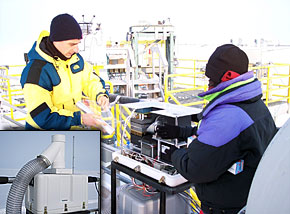New Microwave Radiometer Makes Water Vapor Measurements in the Arid Cold a Snap
Published: 30 April 2005

Scientific research increasingly shows evidence of climate change first appearing in the Arctic. Unfortunately, typical instruments for measuring water vapor—like the microwave radiometers used at the ARM Climate Research Facility Southern Great Plains and Tropical Western Pacific locale—struggle to obtain accurate moisture readings in highly arid conditions like the Arctic. Using a DOE Small Business Innovative Research grant, the ARM Climate Research Facility pursued the development of a microwave radiometer that could operate near 183 GHz—a rate as much as 100 times more sensitive to water vapor than other ARM Climate Research Facility microwave radiometers. In March, ARM Climate Research Facility operations staff and developers from ProSensing deployed a prototype of the new 183 GHz microwave radiometer at the ARM Climate Research Facility North Slope of Alaska site in Barrow. Although similar microwave radiometers have been demonstrated in Barrow for short periods, this prototype will operate through the 2005-2006 winter. This long-term deployment will permit refinements to the design based on actual Arctic conditions and will allow ARM scientists to have access to accurate water vapor measurements over an entire annual cycle.
Because of its very low water vapor content, a region of the infrared spectrum (around 20 µm) that is opaque in most places becomes transparent in the Arctic. That is, infrared energy (heat) that would normally be trapped and used to help regulate the Earth’s global temperature, instead escapes into space. As the Arctic climate warms and causes the thin ocean ice pack to shrink, more open water will be exposed, thereby allowing more water vapor to reach the Arctic atmosphere. This, in effect, will “close the window” at 20 µm, producing yet more warming. The key to modeling this effect is an accurate measurement of the amount of water vapor in the Arctic atmosphere.
The new radiometer actually measures at 183.31 GHz ±1, ±3, ±7, and ±14 GHz. The 183.31 ±1 GHz channel is useful when conditions are very cold and very dry, but as the Arctic winter gives way to spring and then summer, the amount of water vapor increases and the ±1 GHz channel saturates (i.e., the signal no longer increases as the water vapor amount increases). The ±3 and ±7 GHz channels allow the radiometer to still provide useful water vapor data while the ±14 GHz channel permits the amount of liquid water in the thin Arctic clouds to be accurately determined.
The ARM Climate Research Facility is a DOE Office of Science user facility. The ARM Facility is operated by nine DOE national laboratories, including .
Keep up with the Atmospheric Observer
Updates on ARM news, events, and opportunities delivered to your inbox
ARM User Profile
ARM welcomes users from all institutions and nations. A free ARM user account is needed to access ARM data.


















